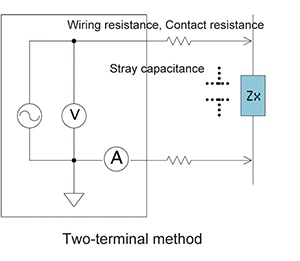LCR meter measurement principles
LCR meter basic measurement principles
LCR meters are measuring instruments that measure a physical property known as impedance. Impedance, which is expressed using the quantifier Z, indicates resistance to the flow of an AC current. It can be calculated from the current I flowing to the measurement target and the voltage V across the target’s terminals. Since impedance is expressed as a vector on a complex plane, LCR meters measure not only the ratio of current and voltage RMS values, but also the phase difference between current and voltage waveforms.

LCR meter measurement circuit: Automatic balance bridge method
The automatic balance bridge method is a circuit design that is used in many LCR meters as the measurement circuit. The circuit has four terminals (Hc, Hp, Lp, and Lc), all of which are connected to the measurement target. See the right for an overview of the circuit and below for a description of the functionality of each terminal.
Hc:
Applies a measurement signal generated with controlled frequency and amplitude to the measurement target. The frequency can be controlled within the range of several millihertz to several megahertz, and the amplitude from 5 mV to 5 V.
Hp:
Detects the measurement target’s Hi potential. The detection circuit’s input impedance is extremely high, allowing accurate detection of the potential without a voltage drop.
Lp:
Detects the measurement target’s Lo potential.
Lc:
Converts the current flowing to the measurement target into a voltage based on the detected resistance and detects the result. The Lc terminal’s potential is always held to 0 V.

LCR meter measurement circuit: Two-terminal method, five-terminal method, and four-terminal-pair method
LCR meters that use the automatic balance bridge method use BNC connectors for all four of their terminals. These connectors incorporate a shielded coaxial design that protects the measurement signals and detection signals from external noise. In general, most detection circuits use the five-terminal method or the four-terminal-pair method. These designs resolve the shortcomings of the two-terminal method, which has the simplest design.
Two-terminal method:
This design contacts the measurement target with two terminals. Measured values include wiring resistance and contact resistance and are significantly affected when the measurement target has low impedance. In addition, due to the existence of stray capacitance between the two cables, the measurement signal flows to the stray capacitance as well as the measurement target during measurement at high frequencies and high-impedance measurement, contributing a source of error.

Five-terminal method:
This method reduces the effects of wiring resistance and contact resistance by using separate cables for signal current and voltage detection. In addition, it reduces the effects of stray capacitance by using shielded cables and placing the shielding portion of the cables at the same potential. This method can be used to reduce measurement error for impedance values ranging from low to high.

Four-terminal-pair method:

